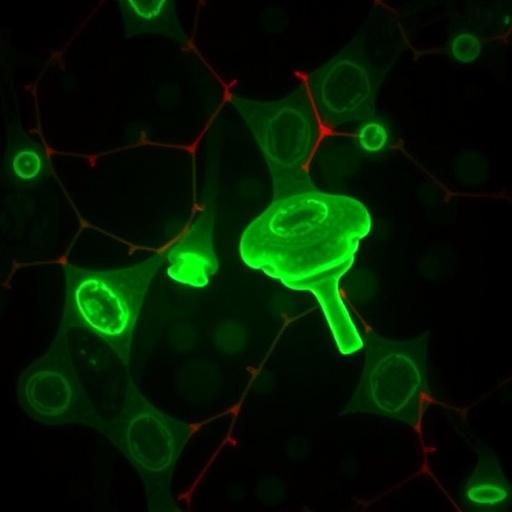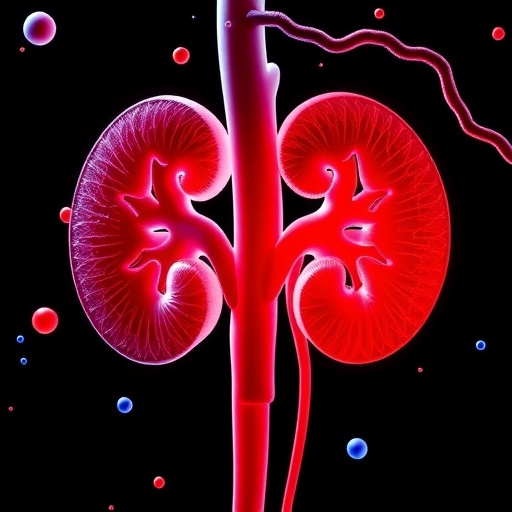In a groundbreaking study that could redefine our understanding of vascular biology and cellular adaptation to low oxygen environments, researchers have uncovered the critical role of plasmolipin in human umbilical vein endothelial cells (HUVECs) survival under hypoxic conditions. This discovery sheds new light on the molecular mechanisms that endothelial cells employ to endure oxygen deprivation, a condition commonly associated with pathological states such as ischemia, tumor growth, and chronic inflammatory diseases. The findings, published in Cell Death Discovery, pave the way towards innovative therapeutic strategies aimed at enhancing vascular resilience and preventing damage induced by hypoxia.
The research team, led by Li, Y., Man, W., and Li, X., embarked on an in-depth exploration to determine how plasmolipin deficiency influences the survival of HUVECs under conditions where oxygen levels are markedly reduced. Plasmolipin, a relatively understudied integral membrane protein, was previously known to localize in myelin and various cell membranes, but its precise function in endothelial cell biology and response to hypoxia remained elusive. Utilizing a combination of molecular biology techniques, knockout models, and cellular assays, the scientists provided compelling evidence articulating plasmolipin as a vital determinant of cell fate during oxygen crisis.
Central to their findings is the discovery that plasmolipin serves not merely as a structural component of the plasma membrane but as an active regulator of signaling pathways that govern cellular adaptation to hypoxia. The absence of plasmolipin in HUVECs triggers a cascade of intracellular events culminating in impaired survival signaling, enhanced apoptotic pathways, and dysfunctional mitochondrial activity. Detailed proteomic analyses revealed altered expression profiles of hypoxia-inducible factors and stress response proteins, underscoring the multifaceted role plasmolipin plays in maintaining endothelial homeostasis under oxygen stress.
A pivotal aspect of the study involved dissecting the molecular interplay between plasmolipin and hypoxia-inducible factor 1-alpha (HIF-1α), a master transcriptional regulator orchestrating cellular responses to low oxygen. The researchers demonstrated that plasmolipin deficiency hampers the stabilization and nuclear translocation of HIF-1α, thereby attenuating the transcriptional activation of downstream genes vital for angiogenesis, metabolism modulation, and survival. By employing chromatin immunoprecipitation assays and reporter gene analyses, the study convincingly linked plasmolipin presence to efficient hypoxic signaling.
Intriguingly, the depletion of plasmolipin was shown to sensitize endothelial cells to reactive oxygen species (ROS)-induced damage, an insight supported by increased oxidative stress markers and compromised antioxidant defenses in deficient cells. This ROS vulnerability exacerbates the detrimental effects of hypoxia, accelerating cellular senescence and death. Conversely, restoration of plasmolipin expression reestablished oxidative balance and fortified the cells against environmental stressors, highlighting its therapeutic potential as a molecular target in vascular pathologies.
The implications of these findings extend beyond cellular survival under hypoxia, touching on critical processes such as angiogenesis and inflammation. Endothelial cells form the lining of blood vessels and are pivotal in forming new vasculature during wound healing and tumor progression. Plasmolipin’s regulatory influence on survival pathways directly affects the integrity and function of blood vessels in hypoxic tissues. Dysregulation or loss of plasmolipin may underlie pathological angiogenesis observed in malignancies or ischemic disorders, providing a new angle for therapeutic intervention.
Methodologically, the study leveraged sophisticated gene-editing tools such as CRISPR-Cas9 to achieve precise plasmolipin knockdown in HUVEC cultures, complemented by RNA sequencing to profile global transcriptomic alterations upon hypoxic challenge. Advanced imaging techniques revealed morphological changes in mitochondrial structure and dynamics linked to plasmolipin status, connecting membrane protein composition with organelle function. The integration of these technical approaches engendered a comprehensive picture of how plasmolipin orchestrates cellular resilience.
Moreover, the authors probed the interplay between plasmolipin and calcium signaling pathways, which are crucial for endothelial function and survival. Aberrations in calcium homeostasis were observed in plasmolipin-deficient cells, potentially disrupting various enzymatic activities and gene expression programs. This finding hints at an intricate network of molecular interactions that plasmolipin governs, ensuring cellular adaptation in fluctuating oxygen environments.
Importantly, this study sets the stage for translational applications. By illustrating that enhancing plasmolipin expression can promote HUVEC survival, it opens avenues for developing gene therapy or small molecule agents aimed at modulating plasmolipin function. Such interventions might improve outcomes in ischemic diseases where endothelial damage is a precursor to tissue necrosis, as well as in cancer therapies where normalizing tumor vasculature could augment treatment efficacy.
The research also addresses fundamental questions in cell biology about membrane protein contributions to environmental sensing and intracellular signaling. Plasmolipin’s role exemplifies how integral membrane components go beyond structural duties, actively participating in complex biological processes essential for life under stress. This paradigm shift may inspire further investigations into similar understudied proteins within various cell types.
Furthermore, the study’s detailed characterization of hypoxia-induced apoptosis pathways in the context of plasmolipin deficiency reveals new molecular targets for preventing endothelial cell death. Limiting apoptosis rates under hypoxia could mitigate vascular complications inherent in diabetes, stroke, and cardiovascular diseases, underscoring the clinical relevance of the findings.
The publication impressively aligns with a growing body of research emphasizing the centrality of mitochondrial health in endothelial function. The documented mitochondrial dysfunction arising from plasmolipin loss links energy metabolism anomalies to compromised cell survival, echoing wider metabolic themes prevalent in biomedical sciences. Therapies aiming to stabilize mitochondria may therefore benefit from considering plasmolipin status.
In synthesizing these insights, the article challenges existing models of hypoxic adaptation by introducing a hitherto unappreciated molecular player. It pushes the scientific community to rethink therapeutic designs that have traditionally targeted downstream signaling or metabolic enzymes, encouraging upstream intervention at the membrane protein level.
As the research community digests these novel findings, further studies will undoubtedly explore plasmolipin’s role in vivo, examining its impact on whole-organism physiology and disease progression. Subsequent work may also clarify whether plasmolipin-related mechanisms are broadly applicable across endothelial subtypes or tissues, broadening its biomedical significance.
Overall, this comprehensive investigation into plasmolipin’s indispensability for endothelial survival under hypoxia provides a compelling narrative, intertwining molecular biology, pathophysiology, and therapeutic potential. It is a potent reminder of the intricacy of cellular life and the ongoing quest to decode it for improving human health.
Article Title: Plasmolipin deficiency is essential for HUVECs survival under hypoxic conditions
Article References: Li, Y., Man, W., Li, X. et al. Plasmolipin deficiency is essential for HUVECs survival under hypoxic conditions. Cell Death Discov. 11, 239 (2025). https://doi.org/10.1038/s41420-025-02526-5
Image Credits: AI Generated
DOI: https://doi.org/10.1038/s41420-025-02526-5
Tags: chronic inflammatory diseases and vascular resilienceendothelial cell response to hypoxiagroundbreaking study on plasmolipin.HUVECs in hypoxic conditionsintegral membrane protein functionsischemia and tumor growthmechanisms of cell fate determinationmolecular mechanisms of oxygen deprivationoxygen deprivation in vascular healthplasmolipin role in endothelial cell survivaltherapeutic strategies for ischemiavascular biology and cellular adaptation





